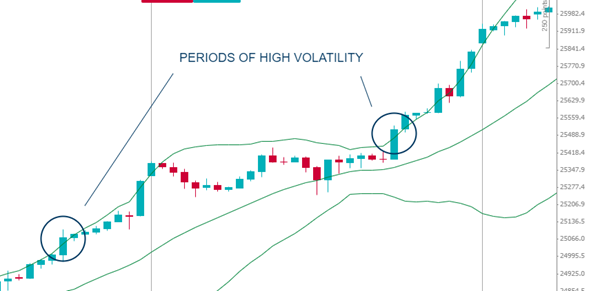High volatility can cause anxiety for traders and investors but with a different mind-set and some preparation, volatility can be great for trading opportunities.
How to think about volatility?
The basic pattern is that the market moves from a period of high volatility to a period of low volatility and back again. Sharp bursts of activity up or down follow periods of relative calm. Periods of calm are an opportunity to plan for the large price moves that will accompany the storm.
The VIX Index, published by the CBOE, is probably the most popular measure of market volatility, but there are others.
Bollinger bands are a good way to visualise volatility. Bollinger bands are drawn two standard deviations away from a 20-period rolling average of the price. The idea is that price will stay within the bands 95% of the time. Price is displaying unusual volatility when it is above the top Bollinger line or below the bottom Bollinger line.
Example of Dow Jones candlestick chart

Source: FlowBank, September 9, 2020
Markets spend most of the time in periods of low volatility, with much less frequent shifts into high volatility. One logical conclusion from this is to assume low volatility but prepare for high volatility.
How to trade with volatility?
Volatility can and should be used to a trader’s advantage. It all comes back to a trader understanding the expected results from (and believing in) their trading system. It is important to understand at what point during the ‘volatility cycle’ the trade will take place.
Some trading systems specifically target the changing levels of volatility. This is especially popular in options trading. Here we are referring to directional trading systems that are looking to capture the underlying price moves, which are affected by changes in volatility.
There are of course 1000's if not an infinite amount of trading systems and trading strategies. But as far as the approach to managing volatility in a directional trading approach, there are two variants commonly used by traders.
1. Trade in low volatility, and wait
These traders enter positions in the “calm before the storm”. This is typically during trend consolidation, or within a price range before an expected breakout.
This approach requires the trader to avoid closing the trade for a small win or loss when volatility is still low; it requires patience. Once the volatility begins, traders will look for a quick exit if price goes the wrong way or if the price moves in the trader’s favour, the key is to not get excited and take profit too quickly.
2. Wait for high volatility and jump in
At its core, this means waiting for a new low price in a trend downwards, or a new high price in an upwards trend. The break of these levels typically coincides with an increase in volatility.
Here the important thing is to make sure to place the trade when volatility picks up. A trader must avoid any concern that it is too late or that the price will reverse, because the strategy is to wait and then assume the volatility will continue.
Incorporating volatility into the understanding of a trading strategy can greatly improve trading success.
Read our next article: Nikola Motor, the new EV* star?





